
If you want the most well-developed chest possible, the bench press is not enough. Sure, big multi-joint lifts are very efficient at putting heaps of meat on your frame, but if you really want to take your muscular development to the next level, you’ll have to include some isolation (single-joint) movements to specifically target individual body parts.
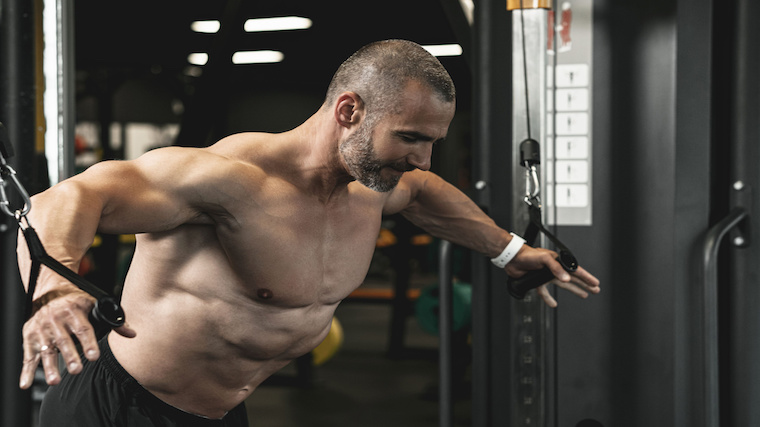
The cable crossover has been a favorite in bodybuilding circles for decades, and for good reason. This chest flye variation allows you to apply high-tension to your pecs without much involvement from other muscle groups. If you’re ready to boost your chest development, take a look at how and why you should add this time-tested exercise to your routine.
How to Do the Cable Crossover
This classic exercise is often performed incorrectly and then blamed for poor results or shoulder pain. Execution is of the utmost importance if you want the best results. Here’s what to do.
Step 1 — Start Between Two Pulleys
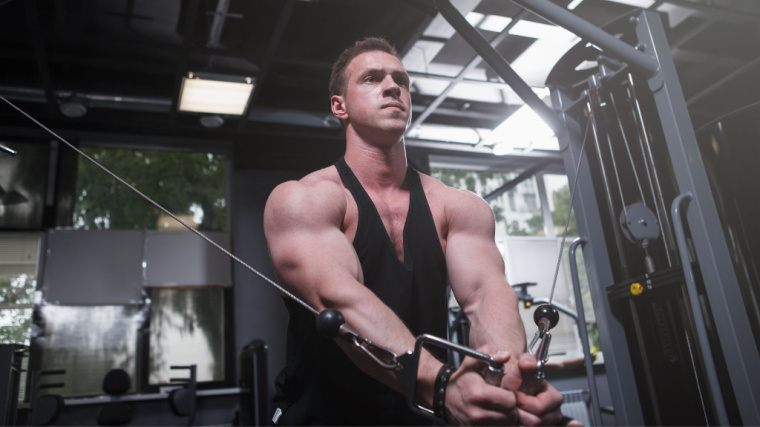
Stand in the middle of a two-pulley station with a single-handle on each side. Some stations have an adjustable pulley height, which is ideal to adapt the exercise to your body. Set each pulley around chest-height.
Grab one handle and pull it in toward your shoulder. Keep it close to your body as you grab the second handle with your free hand. Stand up tall in the middle of the station. Take a deep breath and flex your abs for stability.
Press the handles straight ahead while rotating your palms to face each other. Stop just before your elbows are locked out. This is the starting position for each rep.
Form Tip: You may feel unbalanced or unstable, especially if you start using heavier weights. Use a staggered stance, with one leg in front of you, for a more stable base of support.
Step 2 — Stretch Your Chest
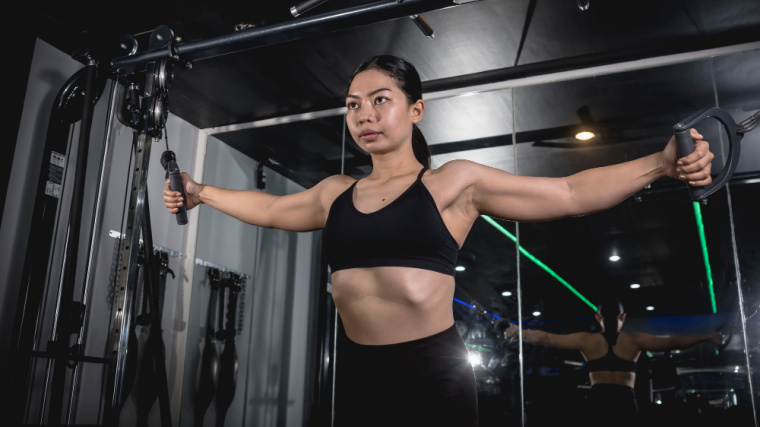
Slowly lower the weight by reaching your arms out to your sides. Keep your chest up, don’t move at the hips or waist. Maintain a slight bend at your elbows throughout the entire repetition — bending and straightening your arms during the movement turns the exercise into a press.
Focus on feeling your pecs (chest muscles) stretch throughout the range of motion. Your shoulder mobility and chest flexibility will determine the end range of motion. Ideally, aim to go until your elbows are roughly in line with your shoulders or as deep as your mobility allows without losing muscular tension.
Form Tip: Do not focus on excessively driving your elbows backwards into an extreme stretch. You’ll risk joint strain and injury, and won’t be able to generate enough force for the exercise to be efficient.
Step 3 — Bring Your Arms to Full Contraction
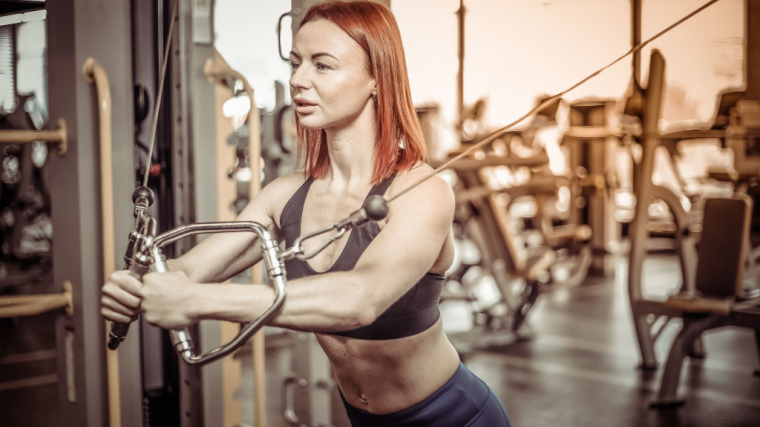
Flex your pecs as you bring your arms to the center. Stop just before your hands touch to keep tension on the muscle.
Your arms should be pointed straight ahead at roughly chest-height. Squeeze your chest as hard as possible in the contracted position. Return to the stretched position and repeat the process for additional repetitions.
Form Tip: Only your arms should move during the exercise. Make sure not to cheat by bending forward at the waist or rolling your shoulders forward. Those adjustments might allow you to move a heavier weight, but it’s at the expense of your shoulder joint health because your shoulders are potentially vulnerable in the stretched position.
Cable Crossover Mistakes to Avoid
Like many chest exercises, the cable crossover is prone to several ego-based mistakes. These can lead to less results and a greater chance of injuries. Let’s take a look at these potential traps.
Pressing the Weight
This can happen either by letting your ego dictate the weight used or by simply losing concentration during a set. In both cases, it drifts away from the purpose of the movement.
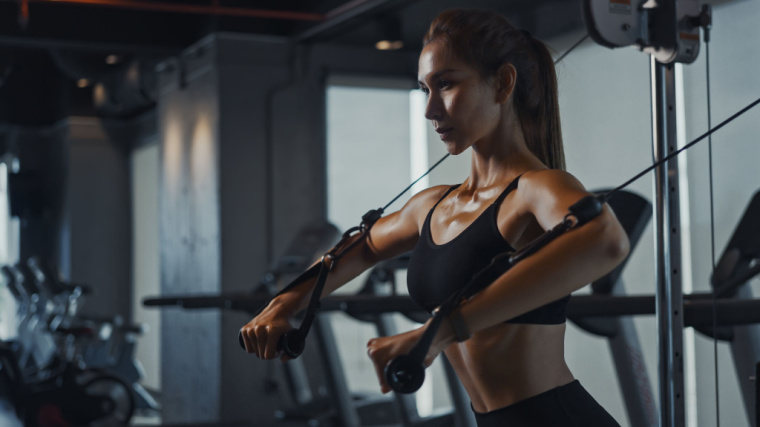
It’s sometimes too easy, or too tempting, to alter the lift’s mechanics so that it turns into a press rather than a flye motion. If you bend your arms too much when the weight begins to move, you will recruit your triceps and, to a lesser extent, the shoulder muscles.
This is a blunder because the aim of the exercise is to isolate the chest as much as possible and not use assistance from other muscles to move the weight.
Avoid It: Your hands should move in a wide arc, from in-line with your shoulders to nearly meeting in the middle. You shouldn’t be driving your hands forward like a bench press or standing push-up. Start the lift with your elbows slightly bent and keep your elbow angle the same during the entire lift.
Overstretching the Shoulder Joint
The cable crossover shouldn’t turn into a weighted stretch. If you lose control, the cable’s tension can pull your hands too far back and extend your shoulders backwards, where the joints are at their most vulnerable.
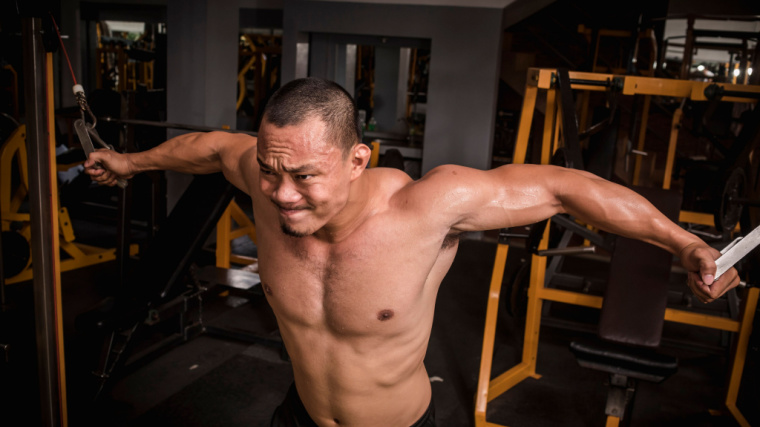
If you’re not mobile enough, this can put unnecessary stress on the shoulder joint. Because of the constant tension applied by the cable, going into a super-deep stretch might not be needed to properly stimulate muscle growth — it will be compensated by strong contraction.
Avoid It: Slow down the eccentric (lowering) portion and always use a manageable weight. This ensures that you’re in control and able to feel consistent muscular tension.
Losing Posture
If you use a weight that is too heavy or push well-past the point when fatigue sets in, you risk losing your posture and letting your shoulders roll forwards. This is often done instinctively so the shoulders can assist the chest.
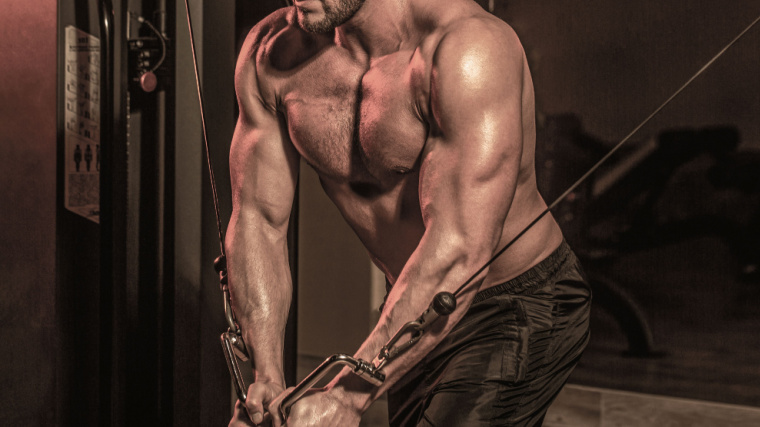
Unfortunately, internally rotating the shoulders in that position is quite risky. It decreases the anatomical space for the many tendons and ligaments that go through the shoulder joint, which results in possible inflammation and tendonitis in the biceps, pecs, or shoulders. It’s also a threat to the fragile rotator cuff.
Moreover, it will decrease the chest stretch, which can decrease the muscle growth stimulus because a stretched muscle under load has the potential to grow more. (1)
Avoid It: Keep your shoulder blades pulled down and back for a stable shoulder position. Stand tall with your chest up and “proud.” Maintain that posture for the duration of the exercise.
Benefits of the Cable Crossover
The cable crossover is an isolation exercise that allows you to really focus on the chest. But there’s icing on the cake because of the adjustable pulley station: you can adjust the pulley’s height and the cables provide constant tension throughout the lift, unlike other exercises such as the dumbbell flye.
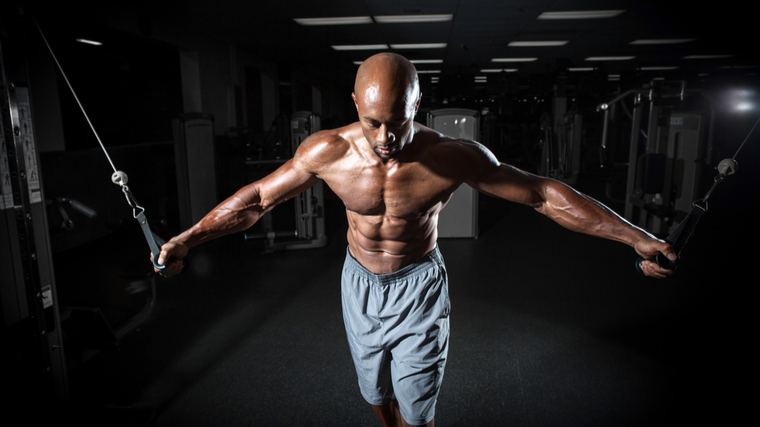
The cable crossover has one primary goal — muscle growth — but it is achieved through different means than a compound exercise like the bench press, and offers its own unique benefits.
Tension Through a Long Range of Motion
If you want optimal muscle-building results, you will eventually have to add variety to your training with different kinds of exercises, rep schemes, or training techniques. (2)
The cable crossover is useful because it challenges the muscle both the lengthened range — because of the deep stretch — and the peak contraction where tension is still applied at the top of the lift.
Dumbbell flye variations, for example, typically have reduced tension in the top position due to the decreased force of gravity against the weights.
Developing the Mind-Muscle Connection
Because of the constant tension applied throughout the whole range of motion, the cable crossover is a fantastic exercise to develop the mind-muscle connection. You can really isolate and focus on the chest in the shortened and lengthened range.
Having a better mind-muscle connection is shown to yield superior muscle growth. (3) Squeezing at the top and pausing on each rep will be a powerful catalyst for building muscle and building a powerful mind-muscle connection.
Versatility
One major advantage of the cable pulley station, compared to a dumbbell or machine flye, is customization. You can use a variety of hand positions or pulling angles, and adjust the weight in small increments.
This allows you to add variation to the exercise and find the perfect setting for you to really feel your chest working. You can also adjust your stance and body position inside the station to find specific cable angles that suit your individual frame.
Muscles Worked By the Cable Crossover
The cable crossover is a single-joint (isolation) exercise that can be one of the most effective ways to directly target the chest if properly done. But the body is a complex machine, and no exercise can really “isolate” a single muscle on its own. Other muscles will always be recruited to some extent.
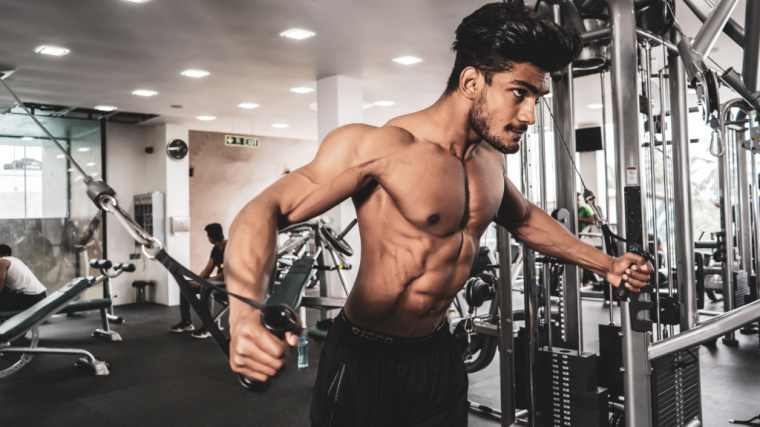
In this case, while the chest is certainly emphasized, nearby muscles will also be activated when performing the cable crossover.
Pectoralis Major
Commonly known as the chest, the pecs are the biggest and strongest pressing muscles in the upper body. The pecs attach to the upper arm, along the clavicle, the sternum, and the upper ribs. During the cable crossover, this muscle is mainly recruited through arm adduction (pulling the arms toward your centerline). The pecs also work to internally rotate the upper arm.
Anterior Deltoid
The shoulder muscle consists of three separate heads — the anterior (front), the lateral (side), and the posterior (rear). During the cable crossover, the anterior head assists the chest with internal rotation and adduction of the humerus (upper arm).
Biceps Brachii
This two-headed muscle is attached to the upper arm and then goes through the shoulder to the scapula (shoulder blade). It is an important muscle in the shoulder complex and helps to stabilize the shoulder joint during the cable crossover. The biceps are recruited because they are responsible for flexing (bending) your arms.
Because your arms should maintain a bend during the exercise, the biceps are working statically during the exercise. You should not actively bend or straighten your arms during the cable crossover because it will shift focus away from your pecs.
Who Should Do the Cable Crossover
Anyone who wants to emphasize their chest development can include this exercise in their routine. This staple exercise is ideal for muscle-building purposes.
Aesthetics Aficionados
If you’re interested in building an aesthetic physique, the cable crossover is a great fit. An isolation exercise is a great way of bringing up an underdeveloped chest while helping to create a symmetrical upper body.
If you need to emphasize chest development with minimum involvement of other muscles, this will be one of your go-to movements.
How to Program the Cable Crossover
Because it’s a single-joint exercise, this exercise should not be used with relatively heavy weights in order to avoid injuries and reap the most of its benefits.
Use the cable crossover as a secondary exercise after your main pressing movement, as a finisher at the end of your chest workout, or (after a thorough warm-up to prepare your shoulder joints) as the first exercise of the session to pre-exhaust your chest for an even more intense workout.
Moderate Weight, Moderate Repetitions
Using the standard hypertrophy scheme of three to four sets of eight to 12 repetitions will be a reliable way to build your chest. Accumulating volume in this range will be beneficial for hypertrophy. (4)
Low Weight, High Repetition
Sometimes you just want to feel the burn. Doing two to three sets of 15 to 20 repetitions can be just as beneficial for hypertrophy, and the longer time under tension might even be better for developing a great mind-muscle connection and really feeling your chest. This is the perfect scheme for a scorching finisher.
Cable Crossover Variations
The cable crossover is great because the pulley station allows you to modify your training in mere seconds. Simply changing the cable’s height will result in a slightly different range of motion and different muscular targeting.
High-to-Low Cable Crossover
For this variation, adjust the cable station so that the attachment is higher than your shoulders. The higher it will be, the more you will emphasize training the lengthened (stretched) position.
Position yourself like you were to perform the standard crossover, but instead of ending the lift with your hands in front of your chest, aim to bring your hands around your belly button or belt-line.
Low-to-High Cable Crossover
Now, we’re doing the opposite by setting the pulleys at their lowest point. Stand tall and balanced with your chest up, like any other cable crossover.
Bring your arms upwards at around face-level. This motion will recruit more the clavicular portion of the pecs (upper chest), similar to incline pressing. Since the upper chest is underdeveloped in many lifters, you should likely give this variation a go, especially if your chest session did not have any incline or overhead training.
Cable Crossover Alternatives
If you don’t have a pulley station or just want to spice things up, don’t worry, we’ve got you covered. Here are the best alternatives to the cable crossover.
Dumbbell Flye
The classic chest flye is free weight alternative to the crossover. Set up a bench, grab a pair of dumbbells, and perform the movement very similar to the cable crossover, but lying down on a flat bench. Because dumbbells are relatively unwieldy compared to cables, this alternative can require more shoulder joint stability, which can be useful for building joint health and injury prevention. (5)
This classic exercise is very interesting because it offers a different curve of resistance than the cable crossover. The moment arm is great in the stretched position, but nearly nonexistent in the contracted position. This alternative will focus on the lengthened range, which can be beneficial for exercise variety, muscle growth, and mobility.
Pec-Deck
The good old machine flye has the benefit of requiring no balance at all and even less coordination. Here, you can solely focus on your chest contraction because you are seated and fully supported. Simply sit in the machine and perform the flye movement.
The guided component allows you to use one unique trick: instead of closing your hands and gripping the handle firmly, just place it in your palms with fingers open. You should be able to feel your chest contract better because the relaxed grip will negate the irradiation phenomenon — also known as Sherrington’s law, which implies that a contracted muscle will also contract the surrounding muscles. (6)
FAQs
I feel my biceps a lot during the exercise. What’s going on?
Your biceps will be tense during the exercise because your arms should be slightly bent with the muscle contracted, but if your biceps are fatiguing before your chest, that’s not normal.
The first step would be to lighten the weight and make sure you’re not actively bending your arms during the exercise. Also, try to think that your hands and forearms don’t exist. You might be activating your arms too much by squeezing the handle too hard. Solely focus on your chest contracting and drawing your elbows and upper arms close together.
My shoulders hurt when I perform this exercise. What should I do?
If it really hurts, then you should stop the exercise and probably consult a medical professional. Some degree of pain or discomfort is unfortunately bound to happen at some point during your lifting journey. It doesn’t necessarily indicate an injury, but it could.
Make sure you always use perfect form. Puff your chest out and keep your shoulder blades back to protect your rotator cuff muscles. If you start rolling your shoulders forward due to fatigue or heavy weights, then you’re opening the door to a potential problem.
Wrap-Up
The cable crossover is one of the few exercises commonly associated with bodybuilding. It’s fundamental purpose is to trigger muscle growth in the chest — and it does that job so well, it’s been a muscle-building staple for decades. If building a fuller, more muscular chest is on your to-do list, the cable crossover should end up in your bodybuilding toolbox.
References
- Nunes JP, Schoenfeld BJ, Nakamura M, Ribeiro AS, Cunha PM, Cyrino ES. Does stretch training induce muscle hypertrophy in humans? A review of the literature. Clin Physiol Funct Imaging. 2020 May;40(3):148-156. doi: 10.1111/cpf.12622. Epub 2020 Feb 5. PMID: 31984621.
- Krzysztofik M, Wilk M, Wojdała G, Gołaś A. Maximizing Muscle Hypertrophy: A Systematic Review of Advanced Resistance Training Techniques and Methods. Int J Environ Res Public Health. 2019 Dec 4;16(24):4897. doi: 10.3390/ijerph16244897. PMID: 31817252; PMCID: PMC6950543.
- Calatayud, Joaquin & Vinstrup, Jonas & Jakobsen, Markus & Sundstrup, Emil & Brandt, Mikkel & Jay, Kenneth & Colado, Juan C. & Andersen, Lars. (2016). Importance of mind-muscle connection during progressive resistance training. European journal of applied physiology. 116. 10.1007/s00421-015-3305-7.
- Schoenfeld BJ, Contreras B, Krieger J, Grgic J, Delcastillo K, Belliard R, Alto A. Resistance Training Volume Enhances Muscle Hypertrophy but Not Strength in Trained Men. Med Sci Sports Exerc. 2019 Jan;51(1):94-103. doi: 10.1249/MSS.0000000000001764. PMID: 30153194; PMCID: PMC6303131.
- Jaggi A, Alexander S. Rehabilitation for Shoulder Instability – Current Approaches. Open Orthop J. 2017 Aug 31;11:957-971. doi: 10.2174/1874325001711010957. PMID: 28979601; PMCID: PMC5611703.
-
Gontijo, L. B., Pereira, P. D., Neves, C. D., Santos, A. P., Machado, D., & Bastos, V. H. (2012). Evaluation of strength and irradiated movement pattern resulting from trunk motions of the proprioceptive neuromuscular facilitation. Rehabilitation research and practice, 2012, 281937. https://doi.org/10.1155/2012/281937
Featured Image: Nestor Rizhniak / Shutterstock






